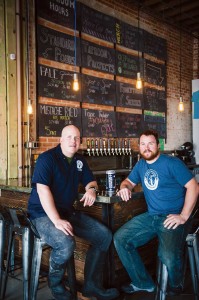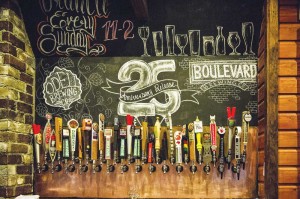According to the Brewers Association, an advocacy group for independent breweries, the economic impact of Texas ’ craft beer market is about $2.3 billion annually, second only to California. However, the layers of state and local liquor laws in Texas ensure that battles will continue to be fought here over how and where beer can be sold.
Texas’ patchwork of laws makes for a complicated beer market. Of the state’s 254 counties, 11 prohibit all sales of alcohol, and 194 limit the alcoholic content of beer sold there. Only 49 “wet” counties allow the unrestricted sale of alcoholic beverages.
“In every election, some place in North Texas is voting [on] alcohol,” said Brown. “We’re still trying to get the entire state wet. Our laws are based on things that happened over a hundred years ago.”
Last year, the Texas Legislature enacted reforms to help Texas’ burgeoning craft brewing industry by easing several restrictions on brewpubs and breweries. The changes took effect in June.

The reforms raised brewpub production caps from 5,000 to 10,000 barrels, raised the production limit on self-distributing breweries from 75,000 barrels per year to 125,000 and for the first time allowed breweries to sell beer directly to consumers to drink onsite.
State Rep. Eddie Rodriguez of Austin authored a bill that eased restrictions on vehicle advertisements by breweries. In an e-mail, Rodriguez said that the legislative efforts were meant to support a growing section of the economy.
“Craft beer is gaining popularity in Texas, especially as communities form around the new breweries and small businesses,” he said “These bills really helped open up and expand that market to meet demand.”
Besides breaking down barriers between breweries and brewpubs, Rodriguez said, the new laws “eliminated an existing discrimination against out-of-state producers.” Previously, a transportation surcharge was added to the retail price of out-of-state beers.
For McWhorter, the most important change in the law is the one that allows Panther Island and other breweries to sell beer to be drunk onsite. He is still prohibited from selling beer for customers to take away. Because he doesn’t yet sell bottled beer to stores either, that means that no one will be enjoying his brews at home anytime soon.
“That’s really frustrating,” he said.
After considering the pros and cons of the new legislation, Goldfuss and Deyo decided to register The Collective Brewing Project as a brewpub.
“We just wanted to be able to sell beer to go,” Goldfuss said. “You can’t do that with a brewer’s permit.”
The higher cap on beer production doesn’t help them now, but Deyo said it may be a benefit down the road. “A barrel is two kegs’ worth, or 31 gallons, so the higher barrel limit is a lot of beer,” he said.
Locally brewed beers are available in a number of places. Rahr products are sold at many area grocery and liquor stores. Martin House brews are available at a smaller number of stores, including Specs, Total Wine, and Central Market. Collective Brewing sells “crowlers” (large to-go cups) and glass growlers (jugs) from their brewery, and Panther Island sells beer from their brewery taproom on Friday evenings. Brews from all four companies can be found on tap at various gastropubs and bars in and around Fort Worth.
********
While Fort Worth’s craft breweries are making steady inroads at area bars and restaurants, a handful of brewpubs, gastropubs, and other bars have gone all-in, betting their businesses’ future on the growing demand for craft beers and, in some cases, actually hiding the macrobrews.
“We keep the big three — Bud, Miller, Coors — out of sight,” Bearded Lady co-owner Shannon Osbakken said. “That allows us to put the focus on introducing customers to better options such as Martin House Gateway Blonde or Real Ale Hans Pils.”
Two pioneering gastropubs, which now have locations in multiple cities, started in Texas in the mid-1990s. The Flying Saucer Draught Emporium, which started in Fort Worth, and Ginger Man, whose first location was in Houston, changed the Texas beerscape forever, offering dozens of craft beers that had been largely inaccessible to the public.
Then in 2011, Carlo Galotto opened one of Fort Worth’s first brewpubs, Zio Carlo Magnolia Brewpub on the Near Southside, balancing the demands of a full-service restaurant and small-scale brewery.
Brewpubs have had mixed results in North Texas since they were legalized in 1993, Brown said.

“Part of the problem was, it was a fresh market, and people came from far and wide to start a brewpub here,” the author said. “A lot of brewers had little experience, and many brewpubs struggled to be successful in both the culinary and brewing aspects of the business.” Over time, he said, “poor management, under-capitalization, and other issues resulted in most of the brewpubs going away in the ’90s. Even now we don’t have a very strong brewpub culture.”
“I think that businesses like restaurants and breweries have their own unique difficulties, and being good at both can be daunting,” said Zio Carlo co-owner Adam Gonzales. “Being a brewpub gives us the unique advantage of being able to build our food and beer pairings from the ground up.”
At Zio Carlo’s, the success of a recent promotion featuring Fort Worth brewery offerings was another sign of the rising local fortunes of craft beers. The week, Gonzales said, was one of the restaurant’s “most profitable ever.”
“Our customers were pumped [over the event],” he said. “We realized we have all these brewers in town now, and we can put this wall up of quality local offerings. It’s totally doable without sacrificing anything.”
In October 2013, The Pour House on West 7th Street underwent a complete re-branding from a sports bar to a veritable paradise for microbrew enthusiasts. The idea started with owner Eric Tschetter, who wanted his bar to be part of the small but burgeoning craft beer market. To oversee the re-vamping, he brought general manager Shawn Howell on board.
Howell, with 13 years of experience working as bartender and then manager at the Flying Saucer, said choosing the beer for 75 newly installed taps was only the first step. Not only did his staff begin taking courses on the craft beer industry, but a free weekly beer education class for customers was set up and run by Drewry, the beer consultant and a long-time friend of Howell’s.
“Once you get into beer, you want to pay more attention to how it’s made,” Drewry said. “But initially you have to get over the fact that you’ve been drinking the same beer your whole life, and it’s time to try something new. We explained beer in more layman’s terms and showed folks how much better it could be.”
For craft beer drinkers, Howell said, it’s less about how drunk you can get and more about enjoying the quality of what you’re drinking.
Initially, a few Pour House customers were confused by the change. Gone were the days of blaring DJ music and large overhead banners for Budweiser. The vast majority of Pour House patrons were open-minded about the change, and there was an uptick of “weekend warriors” chasing the newest place to drink, Howell said.
“You can’t be successful working in craft beer without understanding that knowledge is power,” he said. “That’s what I always tell my staff. We want our servers to be able to speak intelligently with someone who is a craft beer aficionado, and we want them to be able to talk with a Bud Light drinker and transition them to a craft beer that’s drinkable for their palate. Ultimately, craft beer is only 12 percent of the industry, but it’s growing.”
********
According to the Brewers Association, Texas ranks a paltry 42nd in breweries per capita. While that suggests that there may be a large untapped market here for craft beer, Wedemeier said that independent breweries like his can’t rest on their laurels.
“It’s become more mainstream to drink fancy, weird styles of beer from offbeat breweries,” he said. “Now there’s a much larger market for it, but the key is to keep growing the demand side. We have to grow the pie.”
Martin House employees spend part of their day outside the brewery. Recently Wedemeier and his colleagues took samples of their brew to Rodeo Goat, greeting and sometimes surprising burger fans with free cups of craft beer.
“We have to get out there and talk to people who haven’t considered drinking craft beer before,” he said.
“The myth that everyone in Texas wants a light beer is just that — a myth,” Drewry said. “It doesn’t mean they don’t want a lot of flavor. This is a movement, and I’m lucky enough to be able to help it grow. It’s been really awesome.”
Poupore, the MillerCoors vice president, said the craft beer trend isn’t going to wreak huge changes in the beer industry anytime soon.
“It’s still a pretty small segment in Fort Worth,” he said. “But the craft beer drinker is very well educated and discerning. I think the movement has been good for the beer segment as a whole, and we certainly embrace that.”
The average beer drinker, he said, enjoys both craft and macrobrews. Light lagers like Coors Light have a “signature flavor” that fits the palate of most beer drinkers, he said. Consumers will pick up a six-pack of the craft beer they want to try, but they may pick up a case of Miller Lite or Coors Light as the brand they are loyal to. I don’t think we will ever see that changing.”
McWhorter said restaurants and bars have a limited number of taps and aren’t likely to add any, meaning competition will increase as more breweries enter the market.
“It’s already happening,” he said.
Fritz Rahr, reflecting on his brewery’s 10th anniversary, said he never imagined that the region’s craft beer scene would grow as quickly as it has, especially in the last three years.
“I think we’re going to see more breweries and brewpubs opening up here.” Brewpubs, he said, have a lower start-up cost than breweries.
Still, he predicts a slowdown in growth over the next five years. “Some breweries may fall out, and others will find their niche and really go after it,” he said.
“I think the new crop of breweries here and in Dallas is exciting,” he said. “I thought the saturation point would have been hit by now, but it hasn’t, so obviously there’s a huge market in Texas. These other breweries are turning other people on to craft beer, and that’s just increasing the whole market.
“Most of all,” he said, “it’s exciting to see good beer being brewed in Fort Worth.”
Fort Worth freelance writer Edward Brown can be reached at ejb0017@yahoo.com.












Great story, Mr. Brown. Well played, indeed.
Haha. Beat you to the beer-themed cover idea did I?